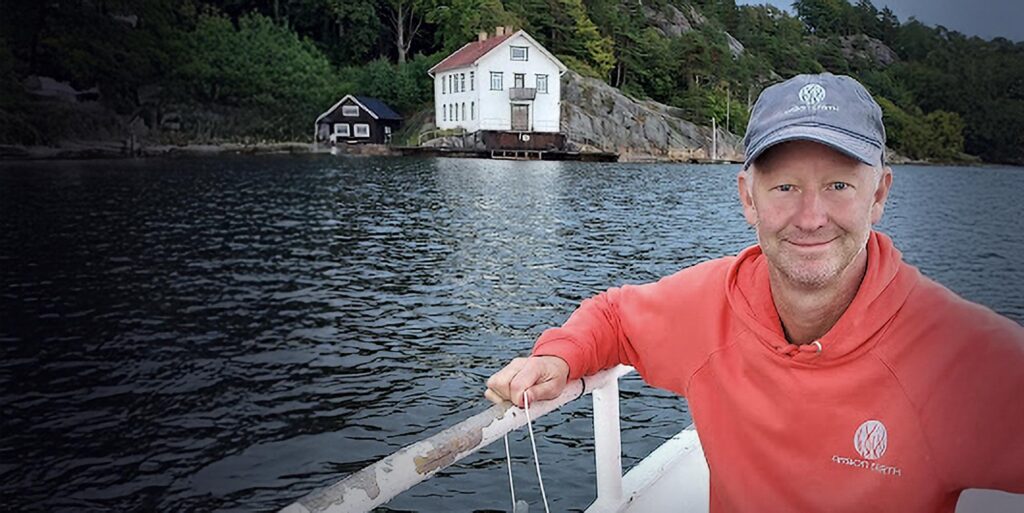
Using algae. – There are many things you can do to reduce the carbon dioxide content in the atmosphere, but several of them are quite ineffective, says Magnus Willner, CEO of Arbon Earth, which collects CO2 in fast-growing algae that are stored on the seabed.
Carbon dioxide traps are a way to tackle the excess CO2 in the atmosphere. One player in this field is the Gothenburg based company Arbon Earth, which participated in C2B2’s Test week 2025 on Bornö a couple of weeks ago.
– A good place to both test things and build networks, says co-founder and CEO Magnus Willner.
For Magnus Willner – a mechanical engineer at heart – various IT solutions are something of a career path.
– It started when I was young and studying in Hawaii. Several people I met there had difficulty finding housing, so I built a system for apartment brokerage.
He has also created software for conducting employee surveys for an OEM in the automotive industry, a system for tennis bookings and built a music game where you can learn to play the piano, guitar and drums. Plus, a payment system for mobile phones … before the now established Swedish system Swish. – But before ours was established, Swish had time to show up.
For a while, he helped build up a group of IT consulting firms, which grew to around 60 employees.
Now focuses on CO2 traps
Today, Magnus Willner is investing his expertise and creativity in the company Arbon Earth, which develops sea-based carbon dioxide traps. Ropes made of natural material are tied to a simple, approximately two-meter-long bamboo tube. They are provided with cuttings of algae, or spores.
The construction – Arbon Earth calls them OceanPods – is then released into the ocean in various places around the world, including in Kenya and Indonesia.
– It must be places with fairly strong outflows and great depths, so islands are often good, he says.
Once out in the ocean, the pods become home to various fish that are given shelter. Then, when the macroalgae have grown large enough, they pull the pod down to the bottom. Down in the darkness, the construction takes with it all the carbon dioxide that the algae have bound up through photosynthesis. And there the carbon dioxide remains, potentially for millions of years.
– It is a solution that has high additionality, high permanence and low emissions, says Magnus Willner.
He compares it with other types of carbon dioxide traps, such as tree planting. Or collecting carbon dioxide and mineralizing it underground – a method called DAC (Direct Air Capture). According to Magnus Willén, tree planting is “the old way”.
– It has low additionality, since it is a natural part of forestry.
Also, a bit uncertain.
– The trees can stand there for fifty years, but then the forest burns up and all the carbon dioxide escapes into the atmosphere.
Expensive and poor results
According to him, when it comes to DAC, the method has – despite large investments and expensive costs per ton – not been able to show any decisive results.
Another way is to produce biochar by burning wood.
– The most common method. 90 percent of all CDR (Carbon Dioxide Removal) projects use it. Unfortunately, the emission figures are high, half of the carbon dioxide goes straight into the atmosphere on the day of burning, he says.
According to Magnus Willner, their own method does not suffer from any of these weaknesses. The additionality and permanence are high, the emissions are low.
Now Arbon Earth is focusing on drawing attention to companies on how, in addition to reducing their carbon footprint, they can also contribute to collecting large amounts of CO2 from the atmosphere, at a low cost.
– It’s about 40 euro a month per employee. The cost is like a gym membership. Then you’re involved and making a difference, he says.
For that cost, according to Magnus Willner, the company will end up in carbon dioxide balance: collecting as much CO2 as they emit.
Startup with potential
So far, Arbon Earth, is being run as a startup. But, he says, the potential is great even if neither they nor anyone else offers the solution with a capital S to the Earth’s climate problems.
– No, one way is not enough, we must work in many ways, broadly.
To develop their product, Arbon Earth needs to be able to document what happens when the pods have sunk to the bottom – they can end up hundreds of meters below the water surface. That’s why they’re now developing equipment to film them.
Testing the method of filming was one of the things they did when they participated in C2B2’s Test Week on Bornö this September.
– We also participated last year, but this year we had a slightly bigger commitment.
How did it go?
– Great, we got several interesting inputs. Then the facility on Bornö and the island itself is a cool environment to be in.
Will you be coming next year too?
– Yes, I would think so, if we have the equipment we need to test. It’s a great opportunity.
Facts: Arbon Earth
The company was founded in 2022 by bland and is based near Chalmers Technical University in Gothenburg, Sweden. Arbon Earth has conducted tests out in the Atlantic Ocean – halfway between Europe and the USA. In Sweden, they have conducted tests in Grebbestad, on Tjärnö, in the Baltic Sea, on Nordön and in the Gothenburg archipelago. Together with researchers at Chalmers, they are developing methods for carbon dioxide storage, including from flue gases. They are also developing a bottom seeder for replanting eelgrass meadows.
Facts: Magnus Willner
Age: 50 years old.
Resident: Hindås outside Gothenburg.
Family: Wife and three children.
Listens to: Everything from musicals to Metallica.
Drives: Lynk&co.
Foto: Torsten Linders